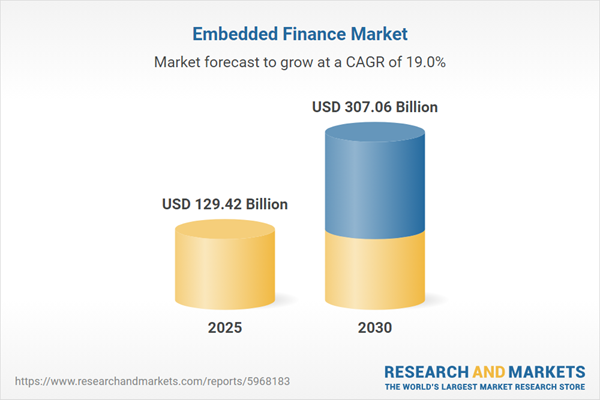Speak directly to the analyst to clarify any post sales queries you may have.
Embedded finance is rapidly redefining how businesses deliver integrated, seamless financial services within their existing digital environments. As financial services become ubiquitous across technology and retail ecosystems, business leaders face evolving challenges and opportunities in shaping strategic growth.
Market Snapshot: Embedded Finance Market Growth and Trajectory
The Embedded Finance Market grew from USD 108.10 billion in 2024 to USD 129.42 billion in 2025. It is expected to continue growing at a CAGR of 19.48%, reaching USD 449.20 billion by 2032. This robust expansion reflects increased integration of digital payment, lending, and insurance functionalities into nonfinancial platforms, rising demand for seamless customer experiences, and the proliferation of mobile and cloud-based applications across industries.
Scope & Segmentation of the Embedded Finance Market
This report delivers a comprehensive analysis of the embedded finance ecosystem, examining the key market drivers, service providers, and user dynamics. The study segments market coverage by component, deployment mode, organization size, industry vertical, end user, region, and profiles major solution vendors. Key subsegmentations include:
- Component: Digital Wallet (Closed Loop Wallet, Open Loop Wallet), Fraud Mitigation, Insurance, Investment, Lending (Buy Now Pay Later, Point of Sale Financing), Payment Processing
- Deployment Mode: Cloud (Hybrid Cloud, Private Cloud, Public Cloud), On Premise (Local Hosting, Private Data Center)
- Organization Size: Large Enterprises, Small and Medium Enterprises
- Industry Vertical: Banking Financial Services Insurance, Healthcare, IT Telecommunications, Manufacturing Logistics, Retail
- End User: Business To Business, Business To Consumer
- Region: Americas (North America, United States, Canada, Mexico, Latin America, Brazil, Argentina, Chile, Colombia, Peru); Europe, Middle East & Africa (Europe, United Kingdom, Germany, France, Russia, Italy, Spain, Netherlands, Sweden, Poland, Switzerland; Middle East, United Arab Emirates, Saudi Arabia, Qatar, Turkey, Israel; Africa, South Africa, Nigeria, Egypt, Kenya); Asia-Pacific (China, India, Japan, Australia, South Korea, Indonesia, Thailand, Malaysia, Singapore, Taiwan)
- Leading Companies Analyzed: Stripe, Inc., Adyen N.V., Block, Inc., PayPal Holdings, Inc., Fidelity National Information Services, Inc., Fiserv, Inc., Shopify Inc., Marqeta, Inc., SoFi Technologies, Inc., Solarisbank AG
Key Takeaways: Strategic Insights for Embedded Finance
- The rapid convergence of technology and finance is dissolving traditional boundaries, enabling financial services to be delivered at the consumer’s point of need and within enterprise value chains.
- Modular platform architectures and standardized APIs are expanding access for fintech providers and third-party developers, leading to faster solution rollouts and greater customization.
- Organizations are prioritizing adaptive fraud mitigation and real-time analytics to enhance security while maintaining a frictionless customer experience.
- Regional variation in regulatory frameworks and technology adoption is influencing market approaches; partnerships blending local expertise with global capability are critical to competitive differentiation.
- Industry verticals as diverse as healthcare, logistics, and retail increasingly embed digital wallets, lending, and insurance modules to drive personalized engagement and transaction efficiency.
- Deployment choices (cloud versus on-premise) are determined by data governance needs, with hybrid cloud supporting scalability and cost management for cross-border and multinational operations.
Tariff Impact: Navigating the 2025 U.S. Trade Landscape
Recent U.S. tariffs have driven up the cost of critical hardware imports, compelling providers of embedded finance to rethink supply chain and pricing models. This has intensified a shift towards cloud-based deployments and domestic manufacturing partnerships to contain costs and maintain agility. The tariffs are also impacting cross-border digital transaction patterns and require recalibration of loan origination and inventory financing frameworks. Businesses are reinforcing their infrastructure to mitigate these external pressures and uphold service continuity across their financial platforms.
Methodology & Data Sources Supporting Embedded Finance Insights
This study utilizes a rigorous multi-step research methodology, integrating C-level executive interviews, firsthand product management insights, and secondary data from industry publications and filings. Quantitative analysis is informed by proprietary transaction datasets and reputable analytics platforms, while regulatory and partnership trends are validated through expert review panels, ensuring accuracy and depth of findings.
Why This Report Matters for Senior Decision-Makers
- Provides a clear roadmap for leveraging embedded finance to create new revenue streams, improve customer retention, and streamline organizational processes.
- Delivers actionable strategies for navigating regulatory complexity and technological disruption across multiple industry contexts and global regions.
- Empowers leaders to benchmark against top market players and identify high-impact investment or partnership opportunities.
Conclusion
Embedded finance is transforming digital business models by integrating financial functions directly into everyday platforms. Decision-makers equipped with these insights can more effectively shape resilient, customer-centric strategies aligned with the evolving market landscape.
Additional Product Information:
- Purchase of this report includes 1 year online access with quarterly updates.
- This report can be updated on request. Please contact our Customer Experience team using the Ask a Question widget on our website.
Table of Contents
3. Executive Summary
4. Market Overview
7. Cumulative Impact of Artificial Intelligence 2025
Companies Mentioned
The companies profiled in this Embedded Finance market report include:- Stripe, Inc.
- Adyen N.V.
- Block, Inc.
- PayPal Holdings, Inc.
- Fidelity National Information Services, Inc.
- Fiserv, Inc.
- Shopify Inc.
- Marqeta, Inc.
- SoFi Technologies, Inc.
- Solarisbank AG
Table Information
| Report Attribute | Details |
|---|---|
| No. of Pages | 192 |
| Published | October 2025 |
| Forecast Period | 2025 - 2032 |
| Estimated Market Value ( USD | $ 129.42 Billion |
| Forecasted Market Value ( USD | $ 449.2 Billion |
| Compound Annual Growth Rate | 19.4% |
| Regions Covered | Global |
| No. of Companies Mentioned | 11 |









